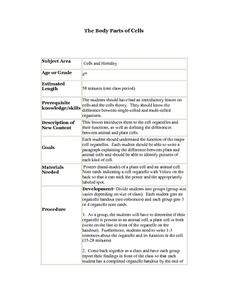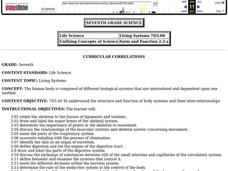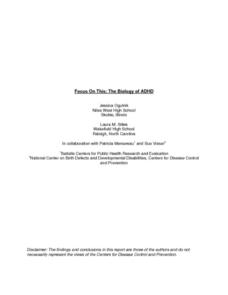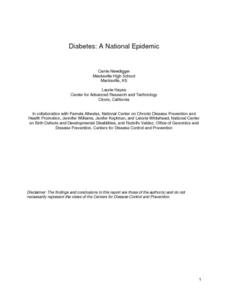Curated OER
The Cell
High schoolers visualize plant and animal cells, explain the parts of a cell and their functions and distinguish plant cells from animal cells. Working Students, in groups, must present a particular portion of a cell to the entire class.
Curated OER
The Body Part of Cells
Eighth graders are introduced to cell organelles and their functions and the they define the differences between animal and plant cells. They write a paragraph explaining the difference between plant and animal cells and students...
Curated OER
Cell City
Students understand how various cell parts function and how they are related to the genetic process by creating a model and symbol to depict the function of the cell parts. They research a cell part to determine function and then cut...
Curated OER
The Incredible, Edible Cell
Students discover organelles and the functions organelles perform in cells. In this biology lesson plan, students create model cells using Jell-o, then dissect their "cell" to examine the parts that create a cell. Students create a...
Curated OER
Prokaryotes and Eukaryotes
Students study prokaryotes and eukaryotes and compare and contrast them. They review the parts of the cell and define th eterms prokaryotes and eukaryotes. In pairs, they identify the organelles in a prokaryotic cell and a eukaryotic...
Curated OER
Creating a Plant Cell Journal
Fifth graders gather information about plant cells. As they read in their science book about plant cells, they take notes on the important facts. Then, they look at their notes and organize them into an outline before they write their...
Curated OER
Organizing Organs
Fifth graders research plant and animals cells and create a Venn Diagram to show the similarities and differences.
Curated OER
Learn DNA Replication
Students explore physical science by participating in a science role-play activity. In this DNA structure lesson, students discuss the different parts of the code that makes up our DNA and instructs our cells. Students utilize the...
Curated OER
Science Lessons
Tenth graders research about the different cell organelles. In this series of biology lessons, 10th graders compare two allotropes of carbon. They investigate how the rate of reaction is affected by concentration.
Curated OER
Energy Transformations
Learners investigate energy and energy transformations. They compare the various forms of energy, create the circuit and sketch the connections. In addition, they label the circuit to identify areas where energy transformation is present.
Curated OER
Feed Me, Seymour
Students work in small groups to create posters illustrating the major facts and functions of plant organs. Within their groups, they assume the role of specialists creating specialized posters pertaining to the different parts of plants.
Curated OER
Human Body Systems
Seventh graders investigate the structure and function of body systems and their inter-relationships. They draw and label the major body systems, observe demonstrations of various body systems, define key vocabulary terms, and compare...
Curated OER
The Dynamic Earth
Pupils participate in assessments related to the layers of the Earth. They read chapters of text, answer questions, watch videos, and identify and label continents and oceans on a map. They design posters, create vocabulary cards,...
Curated OER
The Biology of ADHD
Students investigate the biology of ADHD and its implications upon the formation and treatment of the disease. They draw and label the parts of a neuron. Also, they describe the neurotransmission cycle. Students create a list of pros and...
Curated OER
Shells
Sixth graders label diagrams of the 6 different classes of mollusks and explain the meaning of the labeled terms. They identify 8 common New Haven shells. They organize their own shell collection during this series of lessons.
Curated OER
Methods of Power- Solar, Hydrogen, and Electric
Students examine solar, hydrogen, electric power. In this research based lesson, students will do simple investigations, view videos, discuss, and research how these three types of energy are used for power. They illustrate a...
Curated OER
PARAMECIUM RESPONSES TO STIMIULI
Students design the test they use to examine, how the paramecium move, feed, and react to different types of stimuli such as a drop of vinegar. They conduct a lab experiment using a microscope.
Curated OER
Plants And Pollination
Students describe sexual reproduction in plants, including the process of pollination, how insects assist in pollination, and how pollination differs from fertilization. They also explore the importance of honey bees to Arizona agriculture.
Curated OER
Diabetes: A National Epidemic
Students investigate the disease of diabetes. They observe research results to graph the trends of diabetes to contribute to the problem of being overweight. They explain in class discussion the physiological changes that occur in the...
Curated OER
Hot Weather, Rain Mean Fewer Pumpkins
Students share their knowledge of pumpkins, then read a news article about how hot weather and rain are affecting the pumpkin crop. In this agriculture and current events lesson, the teacher introduces the article with a discussion and...
Curated OER
DNA replication
Students write an essay on the basic steps of the DNA replication process accurately enough to show a complete understanding of the subject. Finally, student correctly identify the polarity of the template strand and match the correct...






















